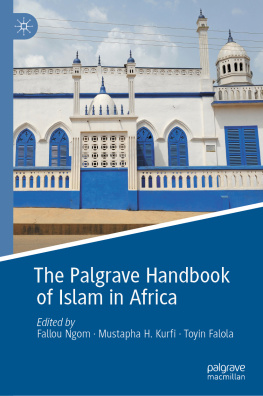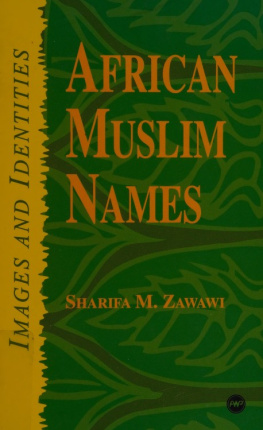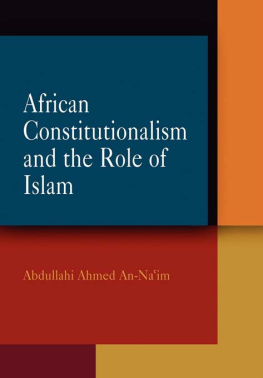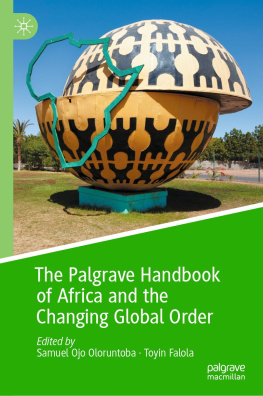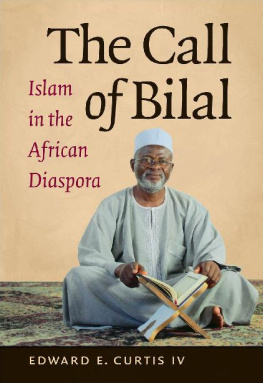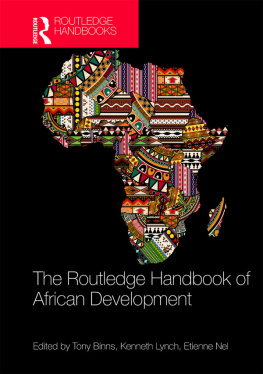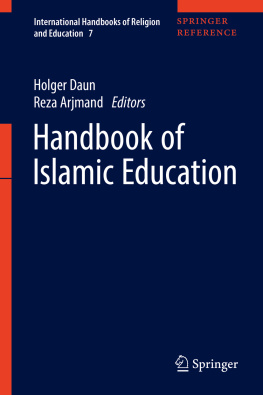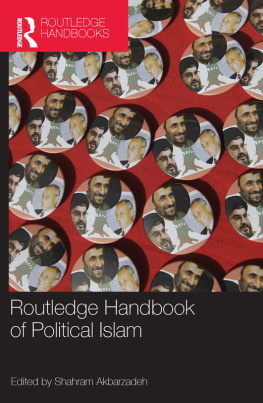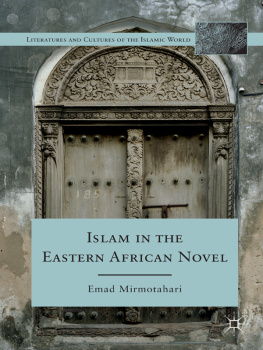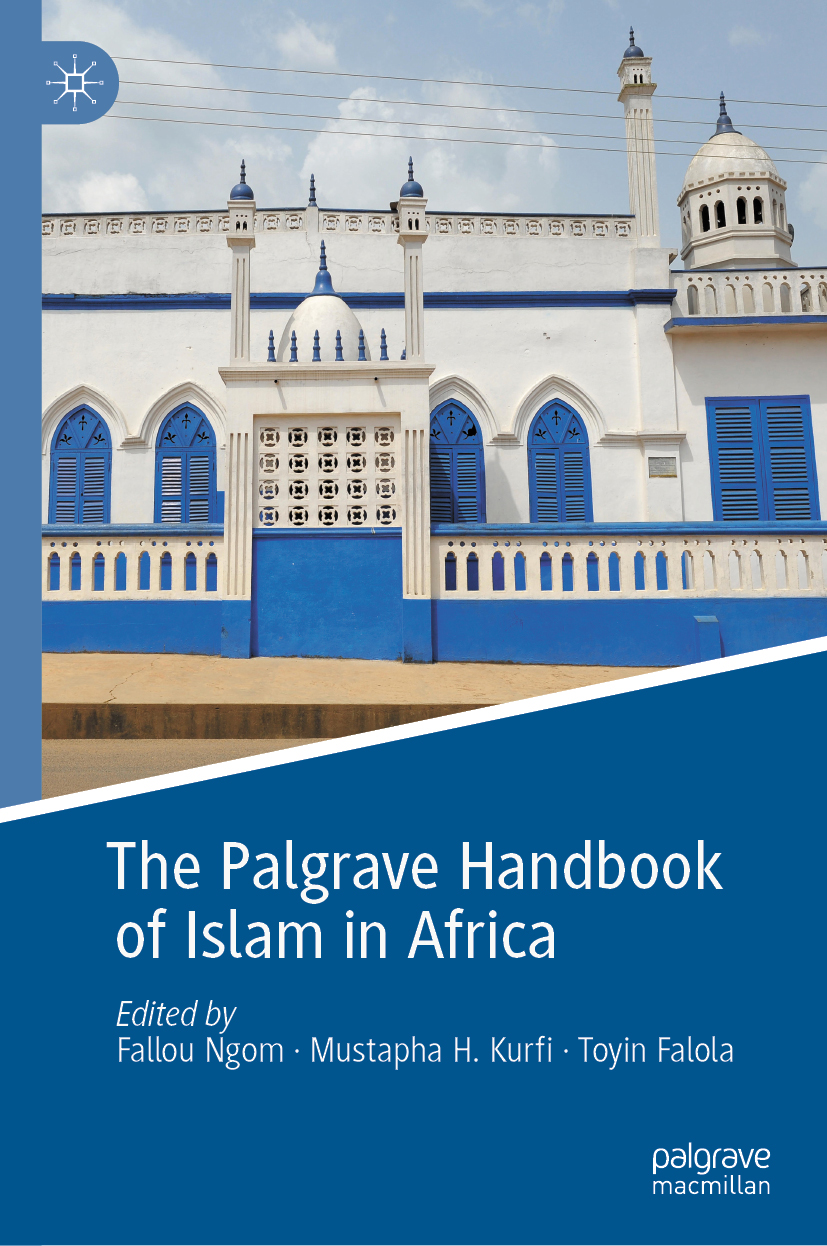Editors
Fallou Ngom , Mustapha H. Kurfi and Toyin Falola
The Palgrave Handbook of Islam in Africa
1st ed. 2020
Editors
Fallou Ngom
Boston University, Boston, MA, USA
Mustapha H. Kurfi
Bayero University, Kano, Nigeria
Toyin Falola
University of Texas at Austin, Austin, TX, USA
ISBN 978-3-030-45758-7 e-ISBN 978-3-030-45759-4
https://doi.org/10.1007/978-3-030-45759-4
The Editor(s) (if applicable) and The Author(s), under exclusive license to Springer Nature Switzerland AG 2020
This work is subject to copyright. All rights are solely and exclusively licensed by the Publisher, whether the whole or part of the material is concerned, specifically the rights of translation, reprinting, reuse of illustrations, recitation, broadcasting, reproduction on microfilms or in any other physical way, and transmission or information storage and retrieval, electronic adaptation, computer software, or by similar or dissimilar methodology now known or hereafter developed.
The use of general descriptive names, registered names, trademarks, service marks, etc. in this publication does not imply, even in the absence of a specific statement, that such names are exempt from the relevant protective laws and regulations and therefore free for general use.
The publisher, the authors and the editors are safe to assume that the advice and information in this book are believed to be true and accurate at the date of publication. Neither the publisher nor the authors or the editors give a warranty, expressed or implied, with respect to the material contained herein or for any errors or omissions that may have been made. The publisher remains neutral with regard to jurisdictional claims in published maps and institutional affiliations.
Contributor: Chuck Bigger / Alamy Stock Photo
This Palgrave Macmillan imprint is published by the registered company Springer Nature Switzerland AG
The registered company address is: Gewerbestrasse 11, 6330 Cham, Switzerland
In gratitude to these
friends, colleagues, and mentors
for their tireless support
Astou Ngom
David Robinson
Douglas A. Kibbee
Eyamba G. Bokamba
James A. Pritchett
John O. Hunwick
Tejumola Olaniyan
Viera Pawlikova-Vilhanova
Yellimane Fall
Preface
The Palgrave Handbook of Islam in Africa builds on the existing knowledge on Islam in Africa, including Nehemia Levtzion and Randall L. Pouwels edited volume, The History of Islam in Africa, published in 2000. It generates new insights that enriches our understanding of the history of Islam in Africa and the diverse experiences and expressions of the faith in the continent. The volume covers key themes that reflects the preoccupations and realities of many African Muslims. It provides readers access to a comprehensive treatment of the past and current traditions of Muslims in sub-Saharan Africa, offering insights on different forms of Islamization that took place in several regions, local responses to Islamization, Islam in colonial and post-colonial Africa, and the various forms of Jihd movements that occurred in the continent. It provides updated knowledge on various social, cultural, linguistic, political, artistic, educational, and intellectual aspects of the encounter between Islam and African cultures reflected in the varied lived experiences and the corpus of African Islamic texts.
Acknowledgments
The project took much longer than expected due to the number of chapters we received and had to edit. We are grateful to all the scholars who have contributed to the volume. The volume would not have been a reality without their commitment and patience. We are also grateful to the reviewers for their useful feedback that improved the quality of many chapters and to Gana Ndiaye for translating Bernard Salvaing and Omar Gueyes chapters from French to English in addition to contributing a chapter to the volume.
Fallou Ngom
Mustapha H. Kurfi
Toyin Falola
Boston, USA Kano, Nigeria Austin, USA
Note on Sources
The volume required working with multiple language materials. We opted for the EI3 transliteration system for Islamic concepts and names of Arab scholars. For African actors, if the name is partly of Arabic origin but is commonly presented in French or English historical materials without diacritics (such as Usman Dan Fodio), we have applied EI3 transcription rules in the first part of the names and kept the name the way it is pronounced locally. Thus, Usman Dan Fodio is rendered as Uthmn an Fodio, Omar Tall is rendered as Umar Taal, and Amadou Bamba Mback is rendered as Amadu Bamba Mbkke, etc. Names of Sufi orders such as the Murdiyya, Tijniyya, Qdiriyya, and others are transcribed following the EI3 system. Arabic words such Al-jj and Q, whether they are titles or parts of first names, are transcribed following EI3 rules with initial letters always capitalized. For names such as Muammad al-Kabr, we have applied the EI3 rules, but use Al-Kabr with the first letters capitalized when it is used alone to refer to the same person. Names of people and places in published materials in French, English, and Portuguese are generally kept as they appear in published materials. We have used Fuuta Jalon and Fuuta Tooro as they are pronounced by native speakers, rather than their various French or English spellings. Finally, mixed words like Ajamization lose their final long vowel diacritic ().
Contents
Fallou Ngom , Mustapha H. Kurfi and Toyin Falola
Part IHistory and Diffusion
Bernard Salvaing
Alfa Mamadou Diallo Llouma
Zachary V. Wright
Fulera Issaka-Toure
Amir Syed
Alpha Oumarou Ba
Karen S. Barton
Bala Saho
Muhammed Haron
Part IIInstitutions and Practices
Erin E. Stiles
Britta Frede
Viera Pawlikova-Vilhanova
Christopher Wise
Assan Sarr
Part IIIIslam and Creativity
Georg Leube
Abdalla Uba Adamu
Cherif Ayouba Correa
Brendan Kibbee
Tigwe Salifu Jebuni
Part IVAfrican Muslims and Knowledge Systems
Mbaye Lo
Babacar MBaye
Ethan M. Key
Liazzat J. K. Bonate
Sara Fani
Part VIslam, Modernity and the Contemporary World
Omar Gueye
Claire Seulgie Lim
Gana Ndiaye
Afis Ayinde Oladosu
Paramole Kabir Olawale and Adeniji Atanda Stephen
Muazu Usman Shehu
Ibrahim N. Abusharif
Toyin Falola
List of Figures
Fig. 2.1 Islam and Christianism in Africa Credit: Jean Salvaing
Fig. 2.2 Muslim Towns and Countries before 1500 Credit: Jean Salvaing
Fig. 2.3 Medieval Empires of the Western Sudan during their Apogee Credit: Jean Salvaing
Fig. 2.4 Islamic States in Western and Central Africa Credit: Jean Salvaing
Fig. 4.1 Screen shot by Zachary Wright (

